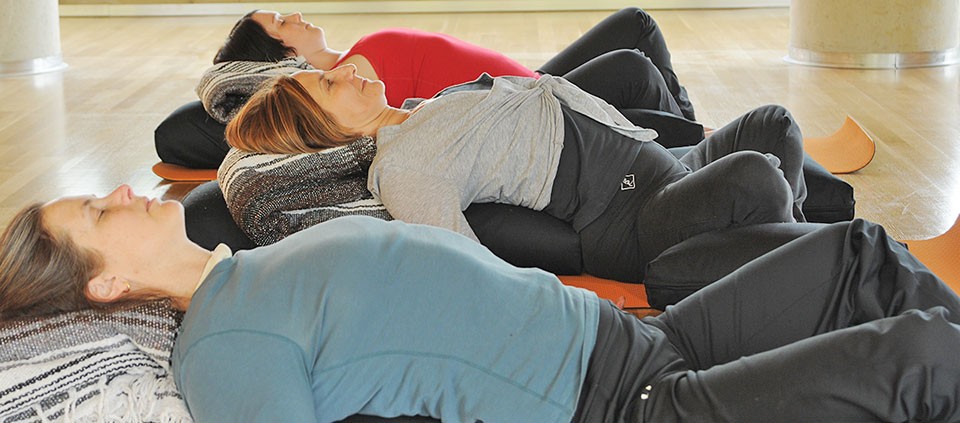Clear Eyes, Soft Heart: What Restorative Yoga Teachers Need to Know

According to Judith Hanson Lasater, who has been teaching yoga for nearly 50 years, one of the most important things yoga instructors can teach their students is simply this: how to lie down on the floor, relax, and let go of tension, stress, and fear.
Judith is a physical therapist and an expert in restorative yoga, an approach in which props are used to support the body in positions of ease and comfort, with the goal of facilitating relaxation and health. As the pace of modern life increases, she says, so does the need for restorative yoga, which is more about stillness than strength, more about pausing than power.
“We’re trying to do too much in a day,” Judith says. “We have full schedules. The result is that the demand for restorative yoga is going up.”
In restorative yoga, gentle reigns supreme. Practitioners sink into postures like Child’s pose, Bridge, and Savasana, supported by bolsters and blankets for maximum comfort. “We’re consciously manipulating the nervous system to create a state of relaxation in the body,” Judith explains. “We cover the eyes, put a bolster under the knees and small pillows under the head and wrists. When you get the joints in flexion, it reminds the nervous system of being in the womb. When you’re relaxed, it’s no longer possible to be anxious.”
Having taught restorative yoga for more than 15 years, Judith believes that a ripple effect occurs when yoga teachers train students to unwind. “Learning how to rest and relax are skills students can take with them forever,” she says, “whether they’re nursing a dying parent or experiencing stress at work or in conflict with a child.”
In addition to reducing anxiety, Judith says, restorative yoga lowers blood pressure and heart rate while increasing the body’s ability to digest, eliminate, and heal. “The body is always seeking balance,” she notes. “If we’re hungry, we eat. If we’re thirsty, we drink. If we’re tired, we sleep. When you lie down and close your eyes, you take the metaphoric weight off your body and it can right itself. Taking the time to do nothing is actually one of the best things you can do for yourself.”
For those who struggle with sleep, restorative yoga presents the ideal segue, encouraging the body’s natural ability to fall asleep and stay asleep. “It teaches you what it feels like to let yourself be sleepy,” Judith says, noting that, in a work-obsessed country like the United States, rest is no longer valued.
“Rest used to be part of the fabric of daily life,” she says. “People had downtime. They took naps. They sat on the porch and read by the fire at night. The Sabbath was a day of rest. We don’t have those rhythms anymore. We’re working all the time. Twenty-minute pauses used to be woven into the structure of our lives—now we need to create them.”
Along with better sleep, restorative yoga practitioners often report benefits such as decreased frequency of migraines, easier menstruation, less reactivity, and enhanced well-being, Judith says. To reap benefits such as these, the body needs to fall fully into physiological relaxation for at least 15 minutes. After 20 or more minutes of relaxation, Judith notes, people begin to experience pratyahara, or introversion, the fifth of the eight limbs of yoga. It essentially means going inward, moving away from outside stimuli. “You begin to notice thoughts arising, and you begin to understand that you are not your thoughts,” Judith says. “For many people, restorative yoga is their first taste of meditation.”
To teach restorative yoga well, instructors need more than a dark, still, warm, environment and the ability to clearly demonstrate postures and use props. They also need to be comfortable with quiet. “Restorative yoga is not about information, it’s about experience,” Judith says. “Teachers have to step back and let students have their own experience.”
They’re also called upon to increase their powers of observation to help students find the optimal posture for total relaxation. “The ability to observe is critical,” Judith says. “You can’t have everyone do it the same way. It’s important to see the subtleties of how each body flows, because slightly different adjustments with props help students go deeper.”
She encourages teachers to go inward and to teach from that place, with a soft heart. “I believe the first job of a yoga teacher is to reflect back to students their inherent goodness and inner wisdom, their equanimity, softness, wholeness, silence, and contentedness—and first you have to find those things inside yourself.”
For Judith, what’s most gratifying about teaching restorative yoga is witnessing its effects. “The best part is that moment of seeing people who are soft and silent and content after they’ve come out of their last pose,” she says. “I get to bask in that, to feel grateful and humbled that I helped create the environment that allowed them to slow down and begin to wake up to themselves.”
Find out about upcoming programs with Judith Hanson Lasater at Kripalu.
© Kripalu Center for Yoga & Health. All rights reserved. To request permission to reprint, please email editor@kripalu.org.
Portland Helmich has been investigating natural health and healing for more than 15 years, as a host, reporter, writer, and producer.
Full Bio and Programs